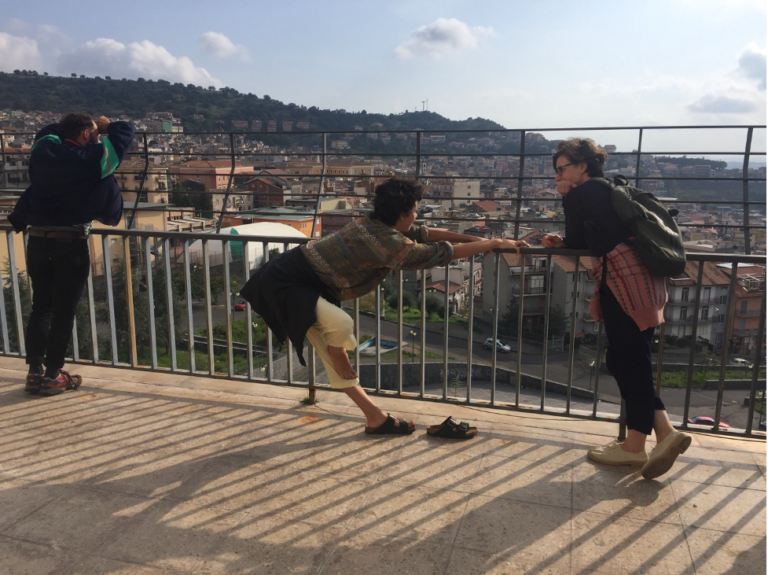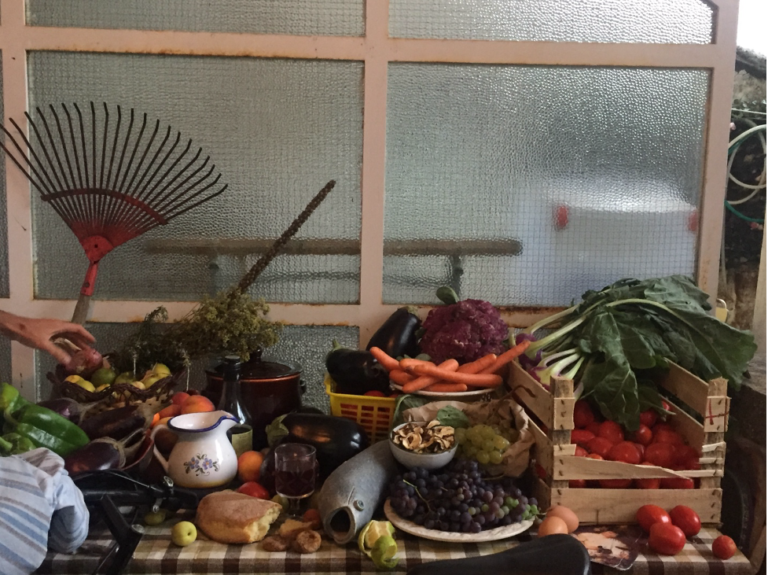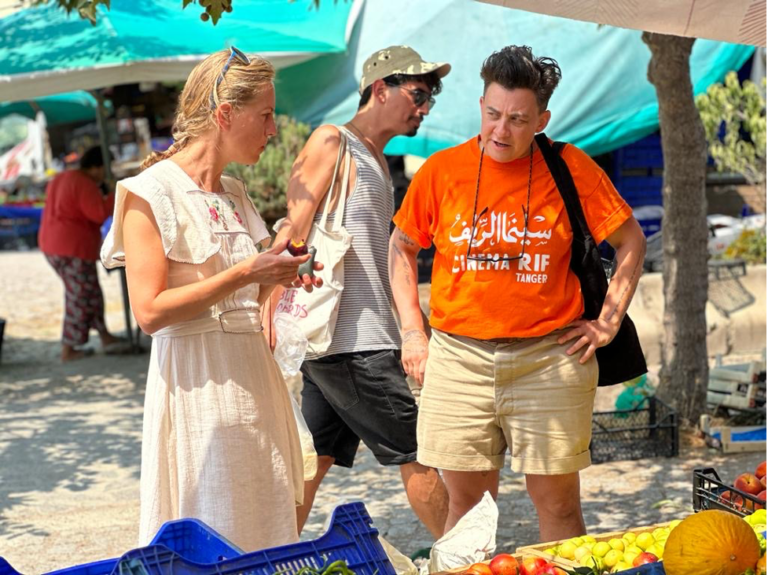Author: Deniz Kirkali
Last January, the co-founder of Garp Sessions, Ayse Idil Idil and I had a Zoom call with art worker, researcher, and member of Fully Funded Residencies, enrico floriddia. Within minutes, we noticed the similar urgencies and perspectives that drove how we both worked and what motivated us to do what we’re doing–let’s call it running independent alternative residency programmes for the purposes of this text.

bi- residency chapter 8, Milo, 2019 – © Enrico Floriddia
Similar Needs, Different Formats
Having been co-running a summer programme that takes place in a fishing town called Babakale in Northern Aegean Turkey, we have refrained from calling the programme an artist residency and therefore, have not really had an interest in looking into other models whose ways of operating resemble or challenge ours. However, talking to enrico led me to reflect on how, despite being based in two very different contexts and operating under very distinct conditions, we share a pressing need to create spaces for ourselves and for others to learn from one another. It is also intriguing to see how our models differ from each other which shows that there are so many ways to organise self-initiated residencies, but at their core they are so similar. An interesting fact I learnt is that similar to our “sessions,” they call each iteration a “chapter” which as enrico suggests give the idea of fragmentary, yet continued, and repetitive collective moments.
Enrico, along with Jérôme de Vienne, Ewa Sadowska, and Angeliki Tzortzakaki, have run for four years bi- which is “a tentative artist residency” or “a collection of discussions, gestures, thoughts, and deeds” in their words. Run by a group of people that is not fixed, they have been issuing “performative open calls” that are designed according to what their ideal artist residency would be.[1] The call does not ask for a CV, portfolio, or a cover letter. Distributed both formally and informally, through word of mouth, it simply invites the applicants to express interest and send in whatever they would like to send in. I am aware that this level of openness can be very intimidating for some people and many others could be critical of the criteria at hand in this selection process. However, it is also an interesting invitation considering how most residencies and programmes operate which compels one to frame their entire practice and network in certain ways that are very much linked to prestige and affiliation. Unlike these dominant models, they realised that “the best candidate was any-one willing to join strangers with fuzzy expectations.” Garp Sessions, on the other hand, is a model that is based on invitation; every summer once we invite the two facilitators who will be deciding on a yearly theme, they invite whoever they’d like from their own networks or circles in conversation with one another. We don’t take part in their decision-making process in terms of concept and participants. We don’t have set criteria for inviting the facilitators, it is a rather intuitive process and we take into consideration whom we’d like to get to know better and learn from. Ayse often calls it a rhizomatic community, which is not limited to us two, but grows through the people every year.
I learn from enrico that they first started bi- simply because they had the space; they had two often-empty family houses in the countryside. I find it a recurring and shared urge between such initiatives to transform personal assets into places that can serve a larger community. It presents a desire to share what is at hand. For me, this opens up a layered conversation point about how we feel about what we have in the arts. There is a lot of discrepancy in the arts which makes it difficult to address, face, and work through one’s privileges. In a system that pushes out many who haven’t had the chance to have a certain formation, flexibility, and who can’t afford to work in these exploitative conditions, sharing resources in possible and generative ways is a strong gesture.

bi- residency chapter 8, Milo, 2019 – © Enrico Floriddia
Creating Encounters Without Pushing for Production
I am a firm believer that when you create certain conditions for people to encounter one another and have the necessary openness to uncertainty, things happen. They might not always lead to concrete and expected results, outcomes, or production, but these encounters prove to be important relationships and community building endeavours. In both bi- residency and Garp Sessions’, expectations are very little. Enrico says; “Since the residents are not getting paid for their time, what can be asked of them is limited.” During their time there, the residents are not expected to work within a theme or produce, but they mostly cook, hang out and create a daily routine. It is the case with Garp Sessions as well. We do have a bit of a structure in the sense that we gather around a theme, set some preliminary material, and ask participants to conduct their own sessions for themselves to be able to bring things from their practice into this pile that is being created throughout our time there, yet, no production is expected. However, although the programme does not focus on production, we have had collective outcomes at the end of some sessions (such as a collectively produced online publication and a performative reading) and have received documentation material from participants–which is something we appreciate having for internal purposes. When we address the necessity of documentation with enrico, he says that their non-hierarchical way of documenting all the material from their chapters almost feels like sharing holiday pictures with friends they did not know one week before.

Garp Sessions, 2023
In September 2024, we ended up publishing a book entitled Garp Sessions 2019-2022 Documentation and New Commissions which invited the past participants to respond to their time in Babakale, share their current projects, produce something new with one another or elaborate on an aspect of the residency. Published by nocturne platform, the book is an attempt to grow our community and open up the very much closed process we have to a larger audience.
Garp Sessions invites a restricted group of people, while bi- usually end up with more people than they initially invited, and it is subject to change in each iteration. Gathering people from various backgrounds, they use this time and space in different ways, but every time find themselves in a different place–new places for future residencies being offered by participants every year. As such, the residency takes place in different locations with different sets of conditions and people. Garp Sessions, on the other hand, is heavily shaped by the locality where the programme takes place. In the past years, the themes, daily routines, and activities have increasingly been influenced by the place itself, its local residents, flora and fauna, and the fishing culture of the village.
Remaining Experimental and Building Support Structures
This brief introduction into the nature of these two residencies shows the structural differences between independent residency/research programmes–there is no right way to initiate one. What strikes the most about projects like bi- and Garp Sessions is how they are both driven by personal and collective needs. They both prioritise remaining experimental while responding to these changing needs even though this experimental mindset might make it difficult to get funding and visibility. At the end of the day, as bi- has put it in a previous text, it is about creating networks of friendships and relations existing beyond the residency programmes, by building support structures that leak into our lives. And this is perhaps exactly what the independent arts and cultural scene needs.
[1] Angeliki Tzortzakaki, Enrico Floriddia, Jérôme de Vienne on behalf of bi-, “Kneading, Resting, Assembling: A Cookbook for Minor Institutions,” Everything Is New
Published on July 2nd, 2024
About the author:
Deniz Kirkali is a curator and writer based between Istanbul and London. She has co-founded topsoil, a transnational curatorial and research collective, and Garp Sessions, a summer programme in Babakale, Turkey. She is the co-author of Otomy, published in 2022 and winner of Volumes Book Award 2022.